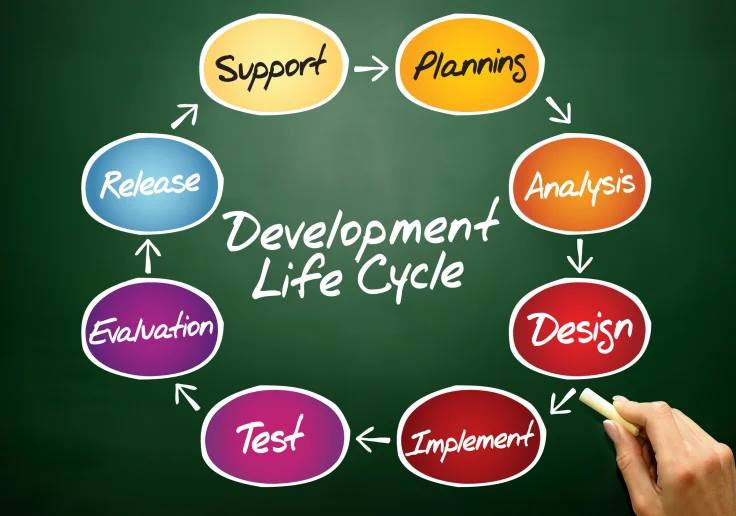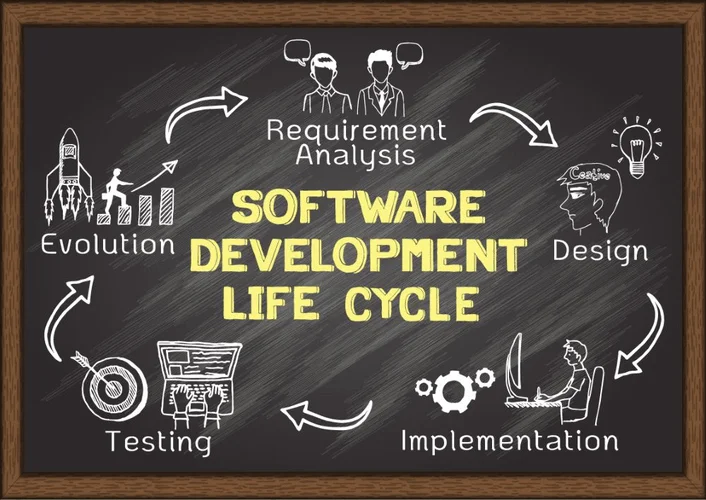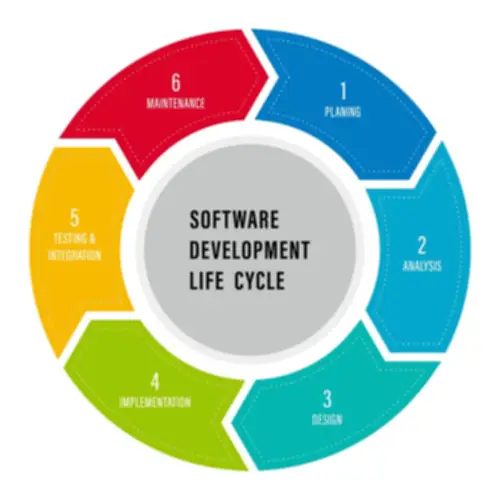System Development Life Cycles: Phases, explanations, and methodologies

The software development process, especially when it comes to complex projects, suggests multiple layers of such factors as customer demands, developers’ tech skills, productive communications between team members with different specialties, and team leaders’ effectiveness in management. Since the IT sector faces challenges in the scope of the intricacy of requirements for software systems tailored to various industries, the need for a range of effective solutions in software development arises.

One of the answers could be to simplify the overall process by breaking it into chunks or phases, where the range of tasks shortens while development team members’ engagement and clarity grow. As a result of such attempts, the System Development Life Cycles (SDLC) framework was born.
What are system development life cycles?
The most common definition of system development life cycles points out a series of steps or phases implemented in software development with the purpose of creating a successful product that meets customers’ requirements.
However, some experienced developers insist that SDLC is an abstraction describing the stages required for software development and the interaction between those phases. Given such a point of view, programmers come to the conclusion that the exact stages of the SDLC framework depend on the basic model of software engineering, system implementation nuances, and the level of demands from the side of the customer.

We are confident that we have what it takes to help you get your platform from the idea throughout design and development phases, all the way to successful deployment in a production environment!
Phases of System Development Life Cycles
Actually, in various system development life cycles, developers consider the interaction between phases differently. Stages here are high-level particles of the process. This is not about low-level details: such as what meetings to hold; whether to write documentation or not. These are addressed by the methodology and development teams’ internal processes but not by the SDLC model itself.
Multiple sources name the phases differently, maybe more or less, but having the same meaning. Here they are:
- Setting the task / Analysis of requirements;
- Development;
- Testing;
- Deployment / Support.
However, to build a basic understanding of the SDLC framework, a beginner developer should have a closer look at the detailed description of the stages. System development life cycles consist of six basic phases often repeated within each new project.
System planning
A successful system cannot be built without first completing the planning process. The planning phase suggests meeting with consumers, suppliers, consultants, and staff to learn how to create a product better than rivals; analyzing the possibilities of alternative solutions; deciding precisely what needs to be done, what issues to address, and what needs to be resolved.
The given information will be used to determine one of three outcomes: create a brand-new system, enhance the current one, or do nothing at all. Customer feedback at this point is crucial.
Methodology analysis
The needs of the system’s final consumer must be determined and recorded so that those needs may be satisfied. An economic and technical explanation is also developed for the project to determine its viability from an organizational, economic, social, and technological perspective. To get a complete understanding of the end product’s purpose, it’s crucial to have an open line of contact with the clientele. In light of the wide variety of individuals and viewpoints, it’s crucial for software developers to find some ground to share.
System design and architecture
After project managers have a firm grasp of the customer’s demands and a clear idea of what must be built, the software engineering team may move on to the design phase. At this stage, the individual parts, modules, interfaces, and data types that make up the system are specified. System design may be done conceptually using a pen and paper; it defines the system’s form and purpose. Next, a comprehensive, in-depth design is created, taking into consideration all logical and physical needs in terms of functionality and technology.
Development, implementation, and deployment
When this step is reached, the system’s needs and specifications are fully understood. After the design of a system is complete, the next step is development. At this stage of a system’s development life cycle, the actual code is produced, and optionally, the necessary settings and configurations are made for the system to fulfill its intended purpose. The system is now ready for start-up and installation at the customer’s location. Users may require orientation and instruction before they can effectively use the technology. Depending on the complexity of the system, the implementation stage might take a lengthy time.
Experimental operation and integration
With this setup, separate parts are brought together to form a whole. The system receives a wide range of inputs, and its output, behavior, and operation are all subject to scrutiny. The importance of testing to customer satisfaction is growing, and it doesn’t even need technical expertise in areas like coding or hardware setup, or design to carry out. Users themselves or a specialized group of in-house staff members may do the testing. Control may be methodical and automated to guarantee the system to deliver the expected outcomes.
Support
At this step, the system is updated on a regular basis to keep it from becoming obsolete. Various components are updated to ensure the system meets the required standards and the newest technologies and is not vulnerable to security risks; this is done via the replacement of outdated equipment and the ongoing review of performance.

Basic SDLC Models
The range of SDLC models is wide. They vary from straightforward Waterfall and Iterative approaches to complex Agile, DevOps, Spiral, and even Big Bang models. The essential difference between them is related to the frequency of SDLC phases and interactions between stages with the possible addition of short cycles to repeat several times within one phase.
Experienced developers traditionally focus on two of the many SDLC models out there, the most effective in practice:
- Waterfall or cascade model;
- Iterative model.
A variety of alternative models, such as the incremental model, the V-model, and the Spiral, are also present in online sources. But with a closer look, it’s tough to spot any defining characteristics of these models or discernible distinctions from the previous two. If someone could explain the key distinctions between the iterative and incremental models, it would be great. Furthermore, the V model may seem impressive on the surface, but it’s really simply a Waterfall approach with tests added to strategic points. There’s a Spiral model, too. Barry Bohm first used it in 1986. In addition, it would be wise to consider risk assessment to be an extension of the iterative technique. Also, it’s challenging to explain how this paradigm is distinct from the iterative one.
Waterfall
In the history of SDLC models, this one comes first. There are widely used nonsense about how the paradigm is “used mostly on important projects.” It was in the 1960s that Waterfall received its current name. Many researchers, however, attack Waterfall’s validity as a framework. Indeed, it occurred throughout the Sixties! The basic idea of the method is that all the needs and complexities of architecture can’t be anticipated in advance. Worst still, the final product might become outdated as developers deliberate over the finer points. Again, it’s impossible to take into account every possible contingency in a forecast.
Developing anything bigger in such a manner is impossible, but the Waterfall model could make sense in tiny projects: short-term and with a team of 1-2 individuals. One may find suggestions of enhancing the Waterfall model by reading the page describing it. However, all of these suggestions lead to going backward, demanding an iteration of some type.
At the same time, some experts describe the Waterfall model as obsolete and it should not be used for new projects.
Iterative model
Using iterative development for every project makes sense. After this cycle, developers will have a functional component of the final product. Showing the goods off to potential buyers and end-users is possible with the iterative approach. Developers can adjust their course based on feedback from customers and find out whether they’re heading in the correct route. The software industry isn’t the only one benefiting from the iterative paradigm.
All of the SDLC phases are completed within a single iteration, following this pattern with each repetition. As an example, in Scrum, each iteration is called Sprint; in RUP, an iteration is simply an iteration, and so on. These models are all built on the iterative paradigm. In Kanban, iteration is the progression of a single task from the first to the final column.
Every kind of project, from the simplest to the most complicated, benefits from the iterative methodology. In fact, developers sometimes employ it covertly by decomposing larger activities into smaller ones.
What SDLC Model is Best?
It’s not simple to answer this question just because SDLC models carry various combinations of phases, suggesting different approaches. For instance, have you ever tried to compare Waterfall with Scrum or Waterfall and Agile? Such a comparison might be incorrect as it’s like comparing a sedan with a helicopter. The thing is that Waterfall is a model, while Scrum is a methodology, while the concept of Agile does not match one or another at all.
Thus the selection of the most productive SDLC model depends on the exact project, its complexity, technologies used in software development, architecture details, customer requirements, and the project’s time-to-market factor.
Despite many studies, the opinion about the effectiveness of techniques, principles, and methodologies is often based on the personal experience, emotional response, and competence of the manager who applied them. And only sometimes will the model you like from the description be the best for implementing your product. Therefore, the more you know methodologies and understand the product needs, the greater your ability to manage projects by combining best practices to achieve the objectives.
The Benefits of SDLC
SDLC is an invaluable tool for software developers. It helps to ensure projects are completed in a timely, efficient, and organized manner. The main advantages of working by cycles are the following:
Provide the highest management control and documentation level. Developers understand what they need to build and why. The plan and goal are adjusted by the customer. SDLC takes into account the specifics of the company’s work and budget.
Give a common language for communication within the team when discussing the development process, which helps experts ensure everyone is on the same page when it comes to the development timeline, roles and responsibilities, and tasks that need to be completed.
Provide a framework for teams to assess their progress and identify areas of improvement. By tracking development tasks and milestones, all members can quickly identify any delays or issues and take the appropriate steps to address them, helping stay on track and ensure the product is released on time and within budget.
Reduce risks and costs. One of the dangerous problems for software is cyberattacks. Hackers regularly threaten businesses, large and small. A data leak can cause severe issues for a company. Therefore, software protection remains a priority. Companies that don’t adhere to a secure SDLC face more vulnerabilities when deploying software.
Detailed verification of the project by testers. Developing successful software requires professionalism and accuracy. Holes in project security will lead to big troubles. All industries are competitive, so top-notch products and services are necessary to stay in business. The cycles give your team the time to create the best projects. Software testing takes place at several stages. Therefore, the risk of error is minimized. The development team eliminates bugs in the early stages. Thus, the project is error-free. With SDLC, there are no unexpected glitches when the design phase begins.
SDLCs are essential to ensure a product meets standards. By following a structured process, teams will monitor if their product meets the expectations of their clients and any issues or bugs are addressed quickly.
Formation of the right company culture. A robust internal culture helps the development team understand that results depend on everyone’s work. A company with the right culture is more likely to collaborate and help each other.
The benefits of SDLC are limitless, and its implementation protects your business from financial risks, reputational damage, and legal penalties. In addition, specialists save time and resources through early misconception detection. It is the best way to build an effective workflow. You can choose one of the trending models and adapt it for your project to discover all advantages.
Where is SDLC Used?
Non-flaming software goods and automated business processes have the potential to scale up enormous organizations. As a result, it is the primary reason why IT goods have grown in popularity. From tiny application development to massive business systems, SDLC is employed practically everywhere. It is a methodical strategy that helps the team to divide large projects into smaller, more achievable pieces. There are several instances of cycles being utilized effectively, including systems for monitoring and regulating medical equipment, inventory management, and customer orders. Consider the following examples:
- cloud computing software
- Apps for mobile and online
- system of business intelligence
- CRM production and resource planning system
The development team ensures that the product is delivered on time and within budget. It also helps to reduce the frequency of mistakes, assuring consistent performance.
In today’s economy, software development entails more than simply programming. It is a difficult endeavor that requires teamwork, adaptability, and good management standards. IT outsourcing nowadays makes technical solutions simple and economical. Work with the Global Cloud Team to ensure that your project is in excellent hands.
Top Articles
How To Choose AI Software For Your Business?
I am here to help you!
Explore the possibility to hire a dedicated R&D team that helps your company to scale product development.






